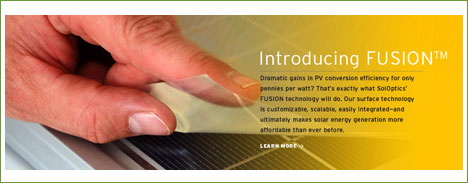|
SolOptics Can Increase Your PV Efficiency – Even on Previously Installed Solar Panels
(Denver, CO) – August 02, 2010 – SolOptics, a division of Genie Lens Technologies, LLC, has announced results from recent performance testing at the NREL for “FUSION™”, its patent-pending photovoltaic enhancement technology. SolOptic's "FUSION" is an optics-based surface technology that substantially increases the conversion efficiency of both new and existing photovoltaic (“PV”) panels. FUSION’s technology utilizes microstructures that can be embossed or cast into either a thin polymer film and then adhered to a PV panel, either in the factory or in the field, or engineered directly into the protective glass layer utilized in most PV panels produced today. 
In tests performed by the NREL at its Golden, Colorado research campus, FUSION delivered conversion efficiency gains ranging from 10 to 12.5 percent (this means if the module had an efficiency of 18% before … it would have efficiency of 19.6% afterwards) depending on testing conditions. FUSION achieved these gains regardless of the underlying PV material for less than $0.10/watt (installed cost). "The FUSION product shows significant improvement in the PV current over existing technology, particularly under various low level lighting conditions," says Keith Emery, Principal Research Supervisor at the Outdoor Test Facility, NREL’s laboratory to characterize the performance and reliability of PV cells, modules, and small systems.
1) It reduces the amount of light that is reflected, especially at lower levels of light (mornings and afternoons). 
2) It ncreases the distance the light travels through the photoelectric material, increasing the production of electricity. 
3) It increases the overall amount of light striking the photoelectric material, thus generating more electricity.

FUSION’s gains in efficiency are amplified by its low cost, driven primarily by its integration into existing glass and plastic film manufacturing processes and its use of readily available and inexpensive materials. In addition, FUSION is the only efficiency boosting technology whose application process can take place in the field -- for the film version -- or at the production facility, and the installation does not require expensive specialized equipment or labor. FUSION can also be customized based on various factors such as higher/lower diffuse light conditions, specific panel manufacturers, or to filter out specific wavelengths of light.
FUSION is engineered using proprietary software that concurrently optimizes multiple design principles, user-specified variables and desired outcomes. The current version of FUSION is a “generic” form that is applicable to a wide cross-section of the market, based upon average insolation and angles of incidence.However, the world is not “one size fits all.” FUSION technology is designed to be incredibly flexible, giving SolOptics the ability to develop custom-engineered versions based on specific requirements, such as higher or lower diffuse light conditions, targeted wavelength filtering or the unique specifications of various panel manufacturers. The result? Efficiency gains at incredibly low cost.
While there certainly seem to be a number of advantages of using FUSION by SolOptics, I suggest you research the following issues before making your final decision: 1) If you add the SolOptics material to your panels, what effect will this have on the product / performance warranties issued by the PV manufacturer. 2) How will it affect the heat buildup of the PV panel (remembering that for crystalline panels – more heat = lower electrical output). 3) PV Panels work best when they are clean – and some PV manufacturers use materials that are better at resisting dust / water spot buildup than others. How will the SolOptics film affect dust / water spot build up over time … and what if any additional maintenance might be required. 4) Which installers in your area have experience installing FUSION. 5) What performance guarantees does SolOptics offer. Back from this page on SolOptics to our lead page on Solar Research
|


